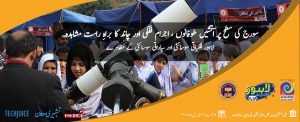KSS’s coordination with Dr. Muhammad Sameed at CERN started in January 2019 who connected us with the MediaLab and introduced us to MediaLab’s leader, physicist Joao Pequenao. Joao likes to call himself a ‘recovering physicist’ and his passion is to amplify physics, in particular particle physics, by using contemporary digital technologies to broad audiences around the world. In March 2019, we extended an invitation to CERN to handhold the building and exhibiting the Large Hadron Collider Interactive Tunnel (LIT). CERN accepted our invitation and we gleefully received Joao as he landed on Allama Iqbal International Airport in the early hours of 8 October 2019.
The Tunnel, since LSM 2019, has been exhibited by us at other exciting outreach events as well. See the Children Literary Festival 2020 and the Shakargarh Science Mela 2022!

As soon as CERN’s presence at the Lahore Science Mela was confirmed, our team comprising avid technologists Shahab Ahmed, Mubashra Manzoor and Abubakar Siddiqi was mobilized in Lahore to initiate the building of the LHC Interactive Tunnel. The KSS had never seen a project of this kind, both in terms of its financial outlay and sophistication. Under Joao’s constant advice, Abubakar scuttled in game shops, electronics warehouses, shopping malls and party decorators and as soon as Joao arrived, and under his skillful leadership, we completed the building of the Tunnel to be eventually up at the Lahore Science Mela.

In the meantime, the KSS assembled a team of young men and women from across the country who would be mentored and taught by the expert-in-residence. Joao taught Junaid Saif and his team the particulars of the Tunnel, gave a tour de force workshop on particle physics, the standard model, improvisation theatre and the art of eloquence for public engagement in science. This training has now left KSS with the capacity to carry on CERN’s mission of propagating physics and educating and inspiring the next generation of scientists.

The LHC Interactive Tunnel is a fully immersive gaming experience that uses accelerometers, motion sensors, short-throw projections on the floor, and a large TV screen on the backdrop,combined with gripping multimedia to educate visitors about particle accelerators, collisions and creation of new particles, the Higgs field, the Higgs boson and using hadrons for healing and therapy. On the occasion of the Lahore Science Mela, the Tunnel was deployed inside an air-conditioned tent on the festival’s location.


Soon after curtains were raised at 9 am on the 12th of October, enthusiasts were siphoned into the chamber in groups of 30 to 50, leaving an estimated 4000 people directly impacted by the exhilarating multimedia experience. As visitors were awed by the performances of protons collisions, Higgs fields and hadron therapy, they also engaged in interactive discussions on topics ranging from the big bang and the expansion of the universe to its ultimate fate, the composition of matter and energy, the meaning of dark energy and dark matter and the origin of fundamental forces. We believe that the Tunnel has influenced and inspired thousands of young minds, instigating them into asking and wondering about all of these subjects, and considering science and physics as a potent medium to start answering some of the most critical questions about the universe.
 View from inside CERN’s LHC Interactive Tunnel.
View from inside CERN’s LHC Interactive Tunnel.
Furthermore, while demonstrators were busy dealing with the throngs of keen inquirers, Joao was often seen slipping out of the tent, only to mingle with the hundreds of students who immediately encircled him and asked him wide-ranging questions about particle physics, mysteries of the universe, elementary particles, gravity, black holes and perhaps, with questions bordering on religious doctrine and science. Joao had immediately acquired the status of a celebrity attending to continuous requests for visual autographs, i.e. selfies.


The LHC Interactive Tunnel at the Lahore Science Mela 2019.
(This is part of a full length report by Dr Muhammad Sabieh Anwar and Charisma Wafee on the Lahore Science Mela 2019. To read the complete report, click here.)


















